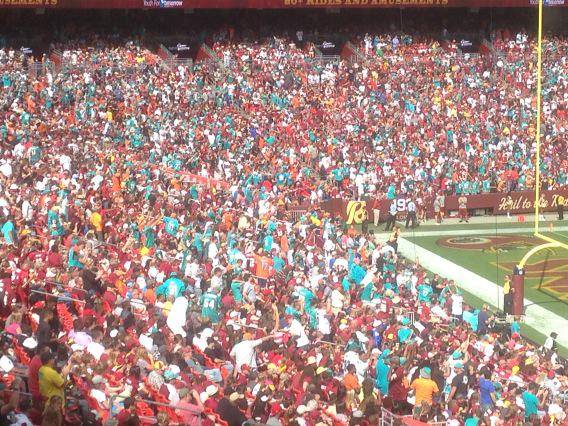- Joined
- Jul 31, 2010
- Messages
- 8,874
Challenge for Rams: Get to Kirk Cousins
Posted by: Bernie Miklasz
http://www.101sports.com/2015/09/17/challenge-for-rams-get-to-kirk-cousins/
When the Rams defense digs into the turf Sunday at FedEx Field, setting up to go after Washington Redskins quarterback Kirk Cousins, their pass rushers can’t waste time. The ball will be gone. Cousins won’t stand around and wait for the Rams to hit him.
Cousins isn’t elusive. He doesn’t scramble much. He will stay in the pocket.
Cousins won’t make anyone’s “Best Quarterbacks” lists. After all, we’re talking about a fourth-year QB that has played in only 15 NFL games including 10 as a starter. He has more career interceptions (21) than touchdown passes (19) and a mediocre passer rating of 76.9.
But Cousins does present a challenge for an aggressive defense that thrives on pressuring and disrupting quarterbacks.
Cousins is one of the quickest draws in the NFL.
He sets up. He fires. He releases the throw before the pass rushers have time to blink.
This is part of coach Jay Gruden’s system. He doesn’t want his quarterbacks to loiter, free-lance, or otherwise hold onto the ball. If you want to play QB for Gruden’s Redskins _ sorry, Robert Griffin III _ then you’d better be decisive and deliver the pass without hesitation.
The Rams have an abundance of active, swarming pass rushers known as “Sack City.” The cast includes defensive ends Robert Quinn, Chris Long and William Hayes. (Plus Eugene Sims, who injured a knee in the season-opener vs. Seattle.) And on the interior are defensive tackles Aaron Donald, Michael Brockers and Nick Fairley. It’s a group that features five first-round draft choices, impressive career sack totals, and enough pass-rush heat to make any quarterback squirm.
Last Sunday “Sack City” got after Seahawks quarterback Russell Wilson for six sacks and 22 total QB pressures. The mobile Wilson couldn’t escape the rush. The Rams trapped him early and often.
This may sound crazy, but Cousins figures to be a more difficult challenge for the Rams.
It’s not because Cousins is the superior quarterback. Obviously, Wilson is the better player. And unlike Cousins _ a stationary target _ Wilson is capable of breaking down a defense with his quicksilver running ability. But in the simple task of getting rid of the football to avoid sacks, Cousins can frustrate a defense with his rapid-fire delivery.
According to Pro Football Focus, Cousins needed an average of only 2.41 seconds to put his passes in flight last season.
In Sunday’s 17-10 opening-afternoon loss to Miami, Cousins averaged 2.32 seconds to release his throw.
In 2014, Cousins used only 2.5 seconds or less to get the ball out of his right hand on 60 percent of his passing attempts. Against Miami, 72 percent of his passing attempts went airborne in 2.5 seconds or under.
That fast release time puts Cousins near the top of the charts among NFL quarterbacks over the past two seasons.
This is what happens when Cousins uses 2.5 seconds or fewer to defy the rush with his quick-release trigger.
In 2014 … a 70 percent completion percentage and a 101.9 passer rating.
Against Miami … a 77.3 completion percentage and a 94.3 passer rating.
But when Cousins holds the ball for more than 2.5 seconds, he’s a different quarterback. And not nearly as good. On his 2.6+ throws last season Cousins completed only 49 percent with a passer rating of 61.5. Facing Miami, Cousins connected on 44 percent of the his 2.6+ passes, threw two interceptions and had a sickly passer rating of only 13.
The Rams’ assignment couldn’t be clearer. Their rushers have to find a way to out-quick Cousins, and it won’t be easy.
Like most quarterbacks, Cousins is more effective when he can throw without harassment.
In his one season (and one game) as Gruden’s quarterback, Cousins has completed 62 percent of his passes with an 80.8 passer rating when the defense doesn’t pressure him. But when the defense puts him under pressure, Cousins has completed only 49 percent of this throws, has two TD passes and five interceptions, and a terrible passer rating of 50.8.
There’s been a lot of talk about the Redskins’ vulnerable offensive line and lapses in pass protection. But the Redskins’ big men kept Cousins relatively clean last week against Miami’s well regarded pass rush. The Dolphins managed one sack and only nine total QB pressures.
Rams quarterback Nick Foles had to cope with considerably more discomfort against the Seahawks, who sacked him twice and swooped in for 16 total pressures. The Rams’ offensive line struggled in its pass protection, with Pro Football Focus giving its lowest pass-blocking grades to left tackle Greg Robinson and right tackle Rob Havenstein. (Center Tim Barnes scored well in his run blocking but got a negative pass-pro grade from PFF.)
Compared to Cousins, Foles has a slower release, averaging 2.7 seconds to get the ball away against Seattle. Foles had about the same timing for Philadelphia last season, and was even more deliberate in 2013 with an average release time of 3.3 seconds. But Foles put that extra release time to good use in 2013, being selected to the Pro Bowl after throwing 27 TD passes and only two interceptions.
The Redskins have at least one menacing pass rusher in outside linebacker Ryan Kerrigan, who roams the edges of a 3-4 defensive alignment to hunt for a pass-protection weakness or mismatch. Left defensive end Stephen Paea had a sack and three hurries vs. Miami last week, and outside linebacker Preston Smith gave the Dolphins as much trouble as Kerrigan.
The young Rams O-line will be tested by the Redskins. Count on it.
And the Rams’ defensive line will have to speed up to put a hit on Cousins before he flicks his wrist.
Thanks for reading …
–Bernie
Posted by: Bernie Miklasz
http://www.101sports.com/2015/09/17/challenge-for-rams-get-to-kirk-cousins/
When the Rams defense digs into the turf Sunday at FedEx Field, setting up to go after Washington Redskins quarterback Kirk Cousins, their pass rushers can’t waste time. The ball will be gone. Cousins won’t stand around and wait for the Rams to hit him.
Cousins isn’t elusive. He doesn’t scramble much. He will stay in the pocket.
Cousins won’t make anyone’s “Best Quarterbacks” lists. After all, we’re talking about a fourth-year QB that has played in only 15 NFL games including 10 as a starter. He has more career interceptions (21) than touchdown passes (19) and a mediocre passer rating of 76.9.
But Cousins does present a challenge for an aggressive defense that thrives on pressuring and disrupting quarterbacks.
Cousins is one of the quickest draws in the NFL.
He sets up. He fires. He releases the throw before the pass rushers have time to blink.
This is part of coach Jay Gruden’s system. He doesn’t want his quarterbacks to loiter, free-lance, or otherwise hold onto the ball. If you want to play QB for Gruden’s Redskins _ sorry, Robert Griffin III _ then you’d better be decisive and deliver the pass without hesitation.
The Rams have an abundance of active, swarming pass rushers known as “Sack City.” The cast includes defensive ends Robert Quinn, Chris Long and William Hayes. (Plus Eugene Sims, who injured a knee in the season-opener vs. Seattle.) And on the interior are defensive tackles Aaron Donald, Michael Brockers and Nick Fairley. It’s a group that features five first-round draft choices, impressive career sack totals, and enough pass-rush heat to make any quarterback squirm.
Last Sunday “Sack City” got after Seahawks quarterback Russell Wilson for six sacks and 22 total QB pressures. The mobile Wilson couldn’t escape the rush. The Rams trapped him early and often.
This may sound crazy, but Cousins figures to be a more difficult challenge for the Rams.
It’s not because Cousins is the superior quarterback. Obviously, Wilson is the better player. And unlike Cousins _ a stationary target _ Wilson is capable of breaking down a defense with his quicksilver running ability. But in the simple task of getting rid of the football to avoid sacks, Cousins can frustrate a defense with his rapid-fire delivery.
According to Pro Football Focus, Cousins needed an average of only 2.41 seconds to put his passes in flight last season.
In Sunday’s 17-10 opening-afternoon loss to Miami, Cousins averaged 2.32 seconds to release his throw.
In 2014, Cousins used only 2.5 seconds or less to get the ball out of his right hand on 60 percent of his passing attempts. Against Miami, 72 percent of his passing attempts went airborne in 2.5 seconds or under.
That fast release time puts Cousins near the top of the charts among NFL quarterbacks over the past two seasons.
This is what happens when Cousins uses 2.5 seconds or fewer to defy the rush with his quick-release trigger.
In 2014 … a 70 percent completion percentage and a 101.9 passer rating.
Against Miami … a 77.3 completion percentage and a 94.3 passer rating.
But when Cousins holds the ball for more than 2.5 seconds, he’s a different quarterback. And not nearly as good. On his 2.6+ throws last season Cousins completed only 49 percent with a passer rating of 61.5. Facing Miami, Cousins connected on 44 percent of the his 2.6+ passes, threw two interceptions and had a sickly passer rating of only 13.
The Rams’ assignment couldn’t be clearer. Their rushers have to find a way to out-quick Cousins, and it won’t be easy.
Like most quarterbacks, Cousins is more effective when he can throw without harassment.
In his one season (and one game) as Gruden’s quarterback, Cousins has completed 62 percent of his passes with an 80.8 passer rating when the defense doesn’t pressure him. But when the defense puts him under pressure, Cousins has completed only 49 percent of this throws, has two TD passes and five interceptions, and a terrible passer rating of 50.8.
There’s been a lot of talk about the Redskins’ vulnerable offensive line and lapses in pass protection. But the Redskins’ big men kept Cousins relatively clean last week against Miami’s well regarded pass rush. The Dolphins managed one sack and only nine total QB pressures.
Rams quarterback Nick Foles had to cope with considerably more discomfort against the Seahawks, who sacked him twice and swooped in for 16 total pressures. The Rams’ offensive line struggled in its pass protection, with Pro Football Focus giving its lowest pass-blocking grades to left tackle Greg Robinson and right tackle Rob Havenstein. (Center Tim Barnes scored well in his run blocking but got a negative pass-pro grade from PFF.)
Compared to Cousins, Foles has a slower release, averaging 2.7 seconds to get the ball away against Seattle. Foles had about the same timing for Philadelphia last season, and was even more deliberate in 2013 with an average release time of 3.3 seconds. But Foles put that extra release time to good use in 2013, being selected to the Pro Bowl after throwing 27 TD passes and only two interceptions.
The Redskins have at least one menacing pass rusher in outside linebacker Ryan Kerrigan, who roams the edges of a 3-4 defensive alignment to hunt for a pass-protection weakness or mismatch. Left defensive end Stephen Paea had a sack and three hurries vs. Miami last week, and outside linebacker Preston Smith gave the Dolphins as much trouble as Kerrigan.
The young Rams O-line will be tested by the Redskins. Count on it.
And the Rams’ defensive line will have to speed up to put a hit on Cousins before he flicks his wrist.
Thanks for reading …
–Bernie





